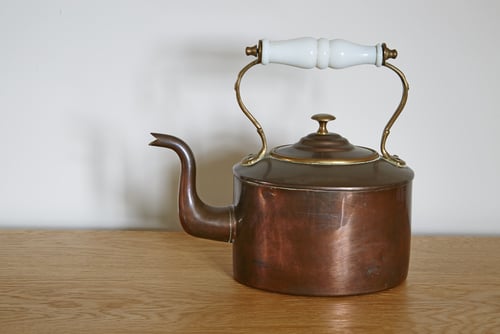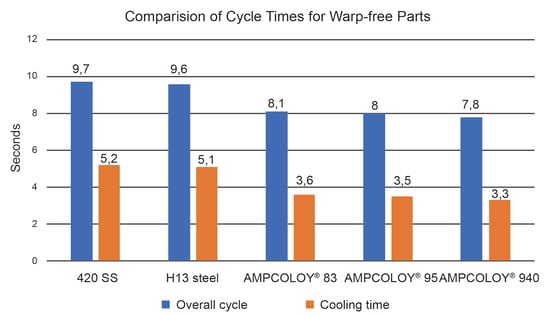Copper is known for many properties: corrosion resistance, electric conductivity, antimicrobial, recyclable – and thermal conductivity. But what exactly is thermal conductivity and why is it so important for certain industries? Let’s have a look together.
Have you ever taken a closer look at a kettle and questioned its design? While the majority of this object is made out of stainless steel, the handle and lid are often made of plastic. Why is that? Well, the reason lies in the different thermal conductivities of the two materials. Stainless steel, like virtually all metals, conducts heat well. This is essential for a kettle as its purpose is to heat water. However, you don't want to burn your hands when boiling water. That's why the handle is made out of plastic, as this material conducts heat very poorly. Thus, the kettle fulfills exactly the purpose it has to fulfill.
 Antique copper kettle with a wooden handle
Antique copper kettle with a wooden handle
What is thermal conductivity of metals?
Thermal conductivity is defined as the ability to transfer heat from a hot object to a cold object. Each material has a different thermal conductivity. It depends on three factors: porosity, water content, and density. In non-metallic solids, thermal conductivity is largely based on the mechanical coupling of neighboring atoms and the associated transfer of vibrational energies.
In metals, on the other hand, the conduction electrons are largely responsible for heat conduction. The same conduction electrons are responsible for electronic conductivity. They ensure that metals have very good thermal conductivity.
The free electrons collide with the lattice particles. Since these vibrate more violently at the heating point, they transfer some of their excess energy to the other electrons on impact. These can move freely in the metal lattice and therefore transfer their previously absorbed additional energy to lattice particles outside the heating point when they collide with them. Solids that are not made of metal do not have free electrons – they, therefore, do not conduct electric current – and are therefore much worse heat conductors.
Copper and its thermal conductivity
Copper conducts electricity very well and is used in many applications for electrical cables. Far less known is that copper also conducts heat well. And it is not a coincidence that pots and pans made of copper are popular for cooking.
There are only a few materials that conduct heat better than copper. One of them, for example, is diamond. No other material has better thermal conductivity than diamond. Diamond achieves its unrivaled thermal conductivity due to its unique crystal structure – the arrangement pattern of atoms. In contrast to metals, heat in diamonds is transported by lattice vibrations and not via the conduction electrons.
 Because of its great thermal conductivity copper is a popular material for heating pipes
Because of its great thermal conductivity copper is a popular material for heating pipes
Silver is the only metal that has a higher thermal conductivity than copper. However, it is only marginally higher. And since both diamond and silver are quite expensive to buy, copper is the most commonly used metal for making conductive devices. This is due to its excellent thermal conductivity, but also to its good electrical conductivity, its high melting point, and its moderate corrosion rate.
Thermal conductivity in the manufacturing industry
Its good thermal conductivity makes copper a sought-after material in the industry. Copper is the first choice wherever rapid heat transfer is required. It is often forgotten that copper not only absorbs heat excellently but also dissipates it. This makes copper an excellent cooler material. For example, copper is used in heat exchangers in air conditioning systems, vehicle radiators, or as processor coolers in computers. And even in the plastics industry, copper alloys like AMPCOLOY® can help make the process more efficient.

Do you want to know more about the metallurgy of copper and copper-based alloys? Download now a free extract of our book «Metallurgy of Copper and Copper Alloys»





